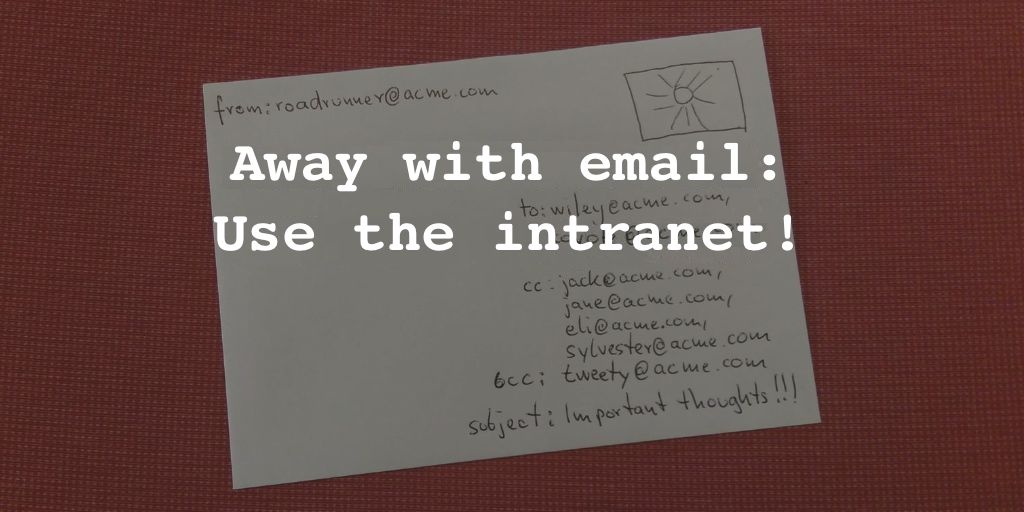Unlike email, an intranet contains information that is valid for a longer time, as well as preserving context and providing options for both synchronous and asynchronous communication.
Email was one of the first forms of electronic communication in companies. Mark Rotert from the Karlsruhe University received the very first email in Germany, sent from Cambridge (Massachusetts) in August 1984.1 It took an entire day for an email to arrive back then! Even at the turn of the century there were some companies whose mail servers sent and received only occasional emails.
But now, all companies use email, and many employees check their inbox to see if they have new mail every minute. One big advantage of email is the simplicity (recipient, subject, text and ready to send). Plus, every company uses email. It is ubiquitous - you can always reach someone in another company via email. Even within a company, email is heavily used, even though the company may recommend another form of internal communication.
But criticism is growing:
Meanwhile, email has become a black hole. People don't respond--or they take forever to respond (which is sort of the same thing). A discussion starts nesting into multiple threads with multiple people and no one can make any sense of it anymore. […] We spend hours per week trying to get rid of unimportant messages.
(John Brandon: Why Email Will Be Obsolete by 2020)
There are many reasons to avoid using email:
- The sender decides that the recipient must do something about the email ("Right! Now the mail is in your inbox, do something with it!").
- The sender indicates the urgency and importance of the message by their choice of words.
- Even though email is an asynchronous communication medium, it's often used synchronously ("Why haven't you answered my email yet? It's already been 5 minutes!").
- When there are multiple recipients (including CC recipients) and multiple replies, the thread of the discussion is no longer comprehensible.
- Instead of personal communication, email is regularly used for mass communication, where the content is decided by the sender (see above).
- Attached documents (Word, Excel, etc.) are used for collaborative work, although even with just two colleagues (one sender and one recipient), multiple emails make it quickly unclear what the actual status of a document is - which is the most recent version?
- New recipients can not see the entire conversation and must first be brought up-to-speed. But who actually does that?
- Even though emails do not indicate when recipients have time for a meeting, many employees use emails to arrange events.
- Email is an information grave, especially when emails land only in the inbox of one employee. The content within the emails is not visible to the company - it is lost knowledge.
Right now, intranets are being used increasingly often and provide more functionality as time goes on. The IT service company Atos, with more than 70,000 employees, is convinced that email will soon lose its importance in the world of business. That's why Atos has been long encouraging a "zero email" diet:
Atos' aim is to reduce internal emails between Atos employees by using improved communication applications as well as new collaboration and social media tools. We believe that email is on the way out as the best way to run a company and do business.
The fundamental problem with email is that it is simply an electronic letter. Wikipedia explains:
Electronic mail, or email, is a method of exchanging digital messages between people using digital devices such as computers, mobile phones and other electronics. ... Email operates across computer networks, which today is primarily the Internet.
For many years, email was the only decent form of electronic communication - the other digital communication services were for too long unreliable or difficult to use. That's why employees used email for everything.
These days, there are a wide variety of useful communication tools in an intranet, such as:
- Blogs
- Collaboration platforms
- Communities
- Social networks
- Microblogs (Yammer or Microblogging for Confluence)
- Messenger and chat groups (Hipchat or Slack)
- Direct messages (Hipchat, Slack or Skype for Business)
- Voice Over IP (Hipchat or Skype for Business)
- Video communication (Hipchat or Skype for Business)
With the increasingly large number of tools available, employees have a greater choice. Each tool has its own advantages. Based on the context (synchronous/asynchronous, sustainable/volatile), an employee can choose the tool that provides the most benefits to them and their company.
Michael Sliwinsky talks about the Pyramid of Communication:
- The Foundation—Level 1: Asynchronous communication with Nozbe and Github
- Moving to 2nd Level: More Synchronous, faster communication: Slack Channels
- 3rd Level—Direct Messages through Slack, iMessage or other Chat clients
- 4th Level—Voice over Skype or FaceTime Audio (or phone 🙂
- 5th Level—Video communication at high bandwidth (Skype Video)
Compared to email, information is more visible and sustainable when in an asynchronous and (partly) public medium like blogs, collaboration tools or communities. Even after several months have passed, the information is still available and easily found. Most importantly, the information is not just visible to mail recipients, but to the entire company.
Only when information is stored within the intranet do other employees have the opportunity, to stumble over useful information by serendipity:
Serendipity is the phenomenon of making unexpected discoveries, a "fortunate happenstance" or "pleasant surprise".
Networking within an intranet (with colleagues who work on similar topics), allows employees to find useful content that would otherwise be hidden. The intranet also provides context (for example, a topic within a community), whereas the context provided by an email subject usually no longer reflects the content by the the third or fourth reply.
An intranet, in contrast to email, allows information to be kept up-to-date and in one location (posts, comments, documents, appointments, tasks). In combination with more synchronous communication tools, an intranet has become an exceptional tool for providing contextual information and enabling enhanced collaboration. Pages and documents can not only be linked to, but previewed and collaboratively developed.
Sources and further reading
- Asynchronous communication - Wikipedia
- Atos: Zero EmailTM
- Atos: Zero email, how to get things done Part one – reaching Inbox Zero
- Atos: Zero email, how to get things done! Part 2
- Atos: Zero email, how to get things done! Part 3
- Email - Wikipedia
- Email ? Collaboration: or… how you can work better and more efficiently …
- Email is the Devil and Must Be Vanquished
- Ist Zero Email überhaupt realistisch? (in German)
- Serendipity - Wikipedia
- Slack, I’m Breaking Up with You
- Synchrone Kommunikation - Wikipedia (in German)
- The Pyramid of Communication in a Remotely Working team — or — how to get meetings done… in many… — No Office, Michael Sliwinsky
- Weniger Kommunikationswahnsinn: Ein Versuch, einige Regeln für E-Mail (und andere Kanäle) aufzustellen (in German)
- Why Email Will Be Obsolete by 2020
I'm of the opinion that our dependence on email should be destroyed.
- "Michael Rotert von der Universität Karlsruhe (TH) empfing unter seiner Adresse „rotert@germany“ eine Grußbotschaft von Laura Breeden („breeden@scnet-sh.arpa“) an der US-amerikanischen Plattform CSNET aus Cambridge (Massachusetts) zur elektronischen Kommunikation von Wissenschaftlern, die einen Tag zuvor (am 2. August 1984, 12:21 Uhr) abgeschickt worden war." (Seite "E-Mail". In: Wikipedia, Die freie Enzyklopädie.) ?
The original article "Raus aus der E-Mail, rein in das Intranet!" was published in German by Frank Hamm.
Frank Hamm
You can find more articles by Frank Hamm in our intranet special.



